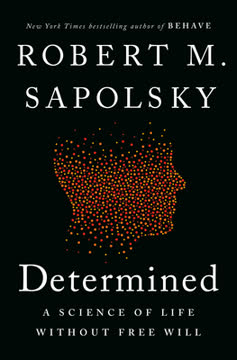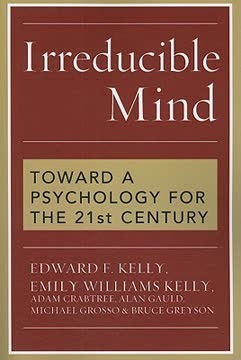Key Takeaways
1. Mainstream Psychology's Materialistic View is Fundamentally Flawed
The authors of this book are united in the conviction that they are not correct—that in fundamental respects they are at best incomplete, and at certain critical points demonstrably false, empirically.
Materialism's failures. The dominant materialistic consensus in psychology, neuroscience, and philosophy of mind, which posits that mind is solely a product of the brain, is empirically inadequate. Behaviorism, the early attempt to reduce psychology to observable behavior, failed to account for complex human cognition and language. The subsequent Computational Theory of the Mind (CTM), viewing the mind as a computer, also proved insufficient, lacking explanations for intentionality, meaning, and subjective experience, as highlighted by philosopher John Searle.
Biological naturalism's limits. The current prevailing view, biological naturalism, which sees consciousness as a biological process of the brain, is the last stand of materialism. While acknowledging the brain's role, this view struggles to explain how subjective experience arises from physical processes. It often relies on promissory materialism, assuming future neuroscience will fill the gaps, but empirical evidence suggests fundamental incompatibilities.
Ignoring crucial data. Mainstream psychology has systematically ignored or dismissed large bodies of empirical evidence that contradict the materialistic framework. This includes phenomena suggesting mind-body interaction beyond known pathways, aspects of memory that seem non-local, and experiences occurring when brain function is severely compromised. This selective empiricism hinders true scientific progress.
2. The Mind is Far More Extensive Than Ordinary Consciousness
Each of us is in reality an abiding psychical entity far more extensive than he knows—an individuality which can never express itself completely through any corporeal manifestation.
Beyond the surface. Ordinary waking consciousness, the "sunlit terrace" of the mind, is only a small fraction of our total psychological reality. There exists a vast, rich, and dynamic region of mental activity operating outside our normal awareness, which Myers termed the "Subliminal Self."
Subliminal activity. This hidden realm is not merely a repository of forgotten memories or a passive processing unit. It is a source of intelligent activity, creativity, intuition, and potentially supernormal capacities. It operates continuously, even when the ordinary mind is occupied or inactive.
Permeable boundary. The boundary between ordinary consciousness (supraliminal) and the subliminal is not fixed but fluid and permeable. Changes in physiological or psychological states can alter this permeability, allowing material from the subliminal to "uprush" into awareness, as seen in dreams, hypnosis, and moments of inspiration.
3. Psychological Automatisms Reveal Hidden, Concurrent Selves
It is therefore to no "automatism" in the mechanical sense, that such acts are due: a self presides over them, a split-off, limited, and buried, but yet a fully conscious self.
Intelligent action without conscious will. Psychological automatisms are actions or perceptions that appear intelligent and purposeful but are not experienced by the individual as originating from their ordinary conscious will. Examples include:
- Automatic writing or speaking
- Hypnotic phenomena
- Dreams and somnambulism
- Creative inspirations
Beyond unconscious cerebration. Unlike earlier physiological explanations that dismissed such actions as mere brain reflexes ("unconscious cerebration"), evidence suggests they arise from genuine conscious intelligence operating outside the primary awareness. These are not just mechanical processes but psychological automatisms.
Multiple, concurrent consciousnesses. In some cases, these automatisms are so complex and coherent that they suggest the presence of distinct centers of consciousness, or "secondary selves," operating concurrently with the ordinary self. These secondary selves can have their own memories, personalities, and even communicate with the primary self or other alters, challenging the notion of a single, unitary consciousness.
4. The Mind Exerts Powerful, Specific Influence on the Body
If anybody says that the will influences matter, the statement is not untrue, but it is nonsense....Such an assertion belongs to the crude materialism of the savage.
Beyond epiphenomenalism. Contrary to the view that consciousness is merely an ineffectual byproduct of brain activity, empirical evidence demonstrates that mental states can profoundly influence physiological processes. This goes beyond general stress responses and includes highly specific effects.
Specific psychophysical effects:
- Placebo and nocebo effects: Beliefs influencing healing or illness.
- Stigmata: Appearance of wounds corresponding to religious imagery.
- Hysterical symptoms: Neurological-like symptoms without organic cause, often following psychological patterns.
- Hypnotically induced changes: Blisters, bleeding, healing, and altered sensory perception induced by suggestion.
- Physiological changes in MPD alters: Distinct allergies, vision, pain sensitivity across personalities.
Influence on others. Even more challenging to materialism are phenomena where one person's mental state seems to influence another's body:
- Maternal impressions: Mother's experiences correlating with birthmarks/defects in the child.
- Distant intentionality: Experimental evidence of one person's intention affecting another's physiology.
These phenomena suggest a volitional capacity that is not limited to the individual's own body and cannot be fully explained by current neurobiological models.
5. Memory is Not Solely Stored as Brain Traces
The successive editions of a feeling are so many independent events, each snug in its own skin.
Critique of trace theories. The conventional view that memories are stored as physical "traces" in the brain, like recordings or images, faces significant conceptual difficulties. Simply reviving a past brain state or image does not inherently constitute remembering; it's just a new event resembling a past one.
Beyond images and symbols. Human memory, particularly episodic (personal) and semantic (factual) memory, involves more than just retrieving stored images or symbols. It includes:
- A sense of past-directedness ("I was there").
- Integration with a vast network of conceptual knowledge.
- The capacity for generality and flexible application of knowledge.
These aspects are not adequately explained by current brain-based models of memory.
Survival of memory? The most profound challenge to brain-based memory theories comes from evidence suggesting that memories may sometimes survive bodily death. Cases of mediumship and young children claiming to remember previous lives, if accepted as veridical, imply that memory can exist and be accessed independently of the physical brain, supporting a non-local view of memory.
6. Consciousness Can Persist and Enhance During Brain Impairment
NDEs in cardiac arrest are clearly not confusional and in fact indicate heightened awareness, attention and consciousness at a time when consciousness and memory formation would not be expected to occur.
Mind beyond the brain's limits. Near-death experiences (NDEs) and out-of-body experiences (OBEs) provide compelling evidence that consciousness can continue, and even be enhanced, when brain function is severely compromised or absent according to current measures.
Experiences during severe impairment:
- NDEs during cardiac arrest: Vivid, complex, and lucid experiences reported when EEG is flat and blood flow to the brain is near zero.
- NDEs during general anesthesia: Experiences occurring when consciousness should be abolished by anesthetic agents.
- Enhanced mentation: Reports of clearer, faster, and more logical thinking during NDEs than in ordinary states.
- Veridical perceptions: Accurate reports of events occurring outside the body's sensory range during NDEs and OBEs.
Challenges to neurobiology. These experiences directly contradict neurobiological models that posit specific brain activity patterns (like gamma oscillations) as necessary and sufficient for consciousness. They suggest that consciousness is not produced by the brain but may be filtered or transmitted through it.
Beyond pathology. While some theories attempt to explain these experiences as hallucinations from a "dying brain," this fails to account for their clarity, coherence, and often transformative nature, which are unlike confusional or pathological states.
7. Genius Springs from Subliminal Uprushes, Not Just Hard Work
"An inspiration of Genius" will be in truth a subliminal uprush, an emergence into the current of ideas which the man is consciously manipulating of other ideas which he has not consciously originated, but which have shaped themselves beyond his will, in profounder regions of his being.
Beyond ordinary cognition. Genius is not merely an amplification of ordinary cognitive processes or tenacious effort. It involves "subliminal uprushes"—ideas, images, or solutions that emerge spontaneously into conscious awareness, often fully formed and with a sense of external origin.
Connection to automatism. These inspirations are psychological automatisms, akin to those seen in dreams, hypnosis, and automatic writing. They often occur in trance-like states and are associated with unusual mental speed, memory, and symbolic thinking. Examples include:
- Calculating prodigies and savants
- Sudden emergence of poems, music, or scientific solutions
- Automatic writing or speaking of creative content
Incommensurability. The products of genius often display a quality "incommensurable" with conscious logical thought, utilizing non-linguistic symbolisms like imagery and metaphor in ways that challenge computational models of cognition. This suggests access to deeper modes of processing.
Beyond pathology. While genius can co-occur with mental illness, it is not caused by it. Both may stem from an unusual openness to the subliminal, but genius involves mastering these uprushes, reflecting a drive toward greater psychic integration and representing a potential future norm for human personality.
8. Mystical Experience Points to a Transpersonal Reality
I think it more likely than not that in religious and mystical experience men come into contact with some Reality or some aspect of Reality which they do not come into contact with in any other way.
Extraordinary states. Mystical experiences are powerful, often transformative states of consciousness characterized by:
- Ineffability (defying verbal description)
- Noetic quality (feeling like profound insight into reality)
- Transiency (brief duration)
- Passivity (feeling received rather than willed)
Universal core. Despite cultural and theological differences in interpretation, there appears to be a universal core experience, particularly the introvertive type characterized by a sense of pure, undifferentiated, unitary consciousness, often accompanied by a feeling of identity with a larger reality or Universal Self.
Beyond subjective illusion. While often dismissed as mere subjective hallucinations, mystical experiences have characteristics suggesting objective significance:
- Consistency across cultures and times.
- Profound and lasting positive transformations in personality.
- Association with genius and creativity.
- Association with supernormal phenomena.
These experiences challenge the view that consciousness is limited to the individual brain and suggest contact with a reality transcending the ordinary physical world.
9. Mystical States Show Consciousness Beyond Ordinary Limits
This overcoming of all the usual barriers between the individual and the Absolute is the great mystic achievement.
Transcending the self. Introvertive mystical experiences involve a radical transformation of the sense of self, where the ordinary ego dissolves into a vastly amplified sense of Self, often experienced as unity with a boundless, universal consciousness. This is not a loss of consciousness but a state of "pure unitary consciousness."
Beyond ordinary perception. Mystical states often involve a sense of perceiving a reality beyond the reach of the physical senses, sometimes described as a "living Presence" or the "hidden order of things." This perception is often non-sensory and non-conceptual, yet feels profoundly real and meaningful.
Paradoxical nature. The experience often defies ordinary logic, involving paradoxical qualities like emptiness being also fullness, or darkness being dazzling. This suggests that the experience occurs in a realm where ordinary conceptual categories do not apply.
Cultivated transcendence. Mystical traditions worldwide have developed systematic disciplines (meditation, prayer, asceticism) aimed at achieving these states by systematically overcoming the conditionings and attachments of ordinary life, suggesting that the capacity for such transcendence is inherent in human nature.
These states represent a form of consciousness radically different from and potentially superior to ordinary waking consciousness, challenging its claim to be the sole or ultimate form of awareness.
10. A Filter or Transmission Model Better Explains Mind-Brain Relation
The function of the brain and nervous system is to protect us from being overwhelmed and confused by this mass of largely useless and irrelevant knowledge, by shutting out most of what we should otherwise perceive or remember at any moment, and leaving only that very small and special selection which is likely to be practically useful.
Brain as a reducing valve. Instead of the brain producing consciousness, the filter or transmission theory proposes that the brain acts as a "reducing valve" or "filter," limiting and shaping a larger, more extensive consciousness to a form useful for biological survival in the physical world.
Explaining anomalies. This model provides a coherent framework for understanding phenomena that challenge the production model:
- Consciousness during brain impairment: When the filter is impaired (e.g., near death, anesthesia), more of the larger consciousness can manifest.
- Supernormal abilities: Psi, genius, and mystical states may represent glimpses of the capacities of this larger consciousness when the filter is loosened.
- Memory: Memory may reside in this larger consciousness and be accessed via the brain, explaining non-local aspects.
- Psychophysiological effects: The larger consciousness may have direct influence on matter, mediated or limited by the brain.
Beyond dualism and materialism. This view is not a return to Cartesian dualism (separate, non-interacting substances) but suggests a different kind of naturalism where consciousness is a fundamental aspect of reality, not merely a byproduct of matter.
Empirical support. The convergence of evidence from diverse phenomena like NDEs, psi, and mystical experiences, which are difficult to explain by production models, lends support to the filter theory as a more comprehensive explanatory framework.
11. An Expanded Empiricism is Needed for a 21st Century Psychology
The rejection of any source of evidence is always treason to that ultimate rationalism which urges forward science and philosophy alike.
Beyond narrow methods. Scientific psychology has limited itself by adhering too rigidly to methods borrowed from physical sciences, often ignoring or dismissing phenomena that don't fit these methods. A truly scientific psychology must embrace a broader empiricism.
Valuable sources of evidence:
- Detailed case studies of unusual individuals (savants, mediums, mystics).
- Field investigations of spontaneous phenomena (apparitions, deathbed visions).
- Cross-cultural studies of altered states and transformative practices.
- Experimental studies using methods tailored to the phenomena (hypnosis, Ganzfeld, meditation).
Integrating subjective and objective. Future research must integrate third-person objective observation with first-person subjective reports, recognizing the value of both for understanding consciousness and altered states.
Openness to new data. Psychology must overcome its historical bias against phenomena associated with religion or the "supernormal" and evaluate all evidence with an open mind, allowing data to challenge existing theories and potentially lead to a more complete understanding of human nature.
Last updated:
FAQ
1. What is Irreducible Mind: Toward a Psychology for the 21st Century by Edward F. Kelly about?
- Comprehensive challenge to materialism: The book critically examines mainstream materialist views in psychology and neuroscience, arguing they are incomplete and unable to explain many empirical phenomena related to consciousness.
- Integration of neglected research: It revives and builds upon the work of F. W. H. Myers and William James, especially their theories of the Subliminal Self and the filter/transmission model of mind-brain relations.
- Broad empirical scope: The authors systematically review evidence from psychical research, altered states, near-death experiences, mystical states, genius, and psychedelic experiences to propose a more expansive scientific psychology.
2. Why should I read Irreducible Mind by Edward F. Kelly and colleagues?
- Critical examination of orthodoxy: The book offers a rigorous, evidence-based critique of dominant physicalist and computational theories of mind, encouraging readers to question foundational scientific assumptions.
- Interdisciplinary and integrative: It synthesizes findings from psychology, neuroscience, philosophy, and psychical research, providing a rare, synoptic perspective on consciousness.
- Future-oriented framework: The authors propose new research directions and theoretical models that can accommodate anomalous and transpersonal phenomena, making it essential for those interested in the mind-body problem and the future of psychology.
3. What are the key takeaways from Irreducible Mind regarding the mind-body problem?
- Materialism is insufficient: The book argues that the view of mind as entirely brain-produced is empirically and conceptually inadequate, especially in light of phenomena like psi, near-death experiences, and psychological automatisms.
- Alternative models proposed: It revives the filter or transmission theory, suggesting the brain acts as a filter for a broader consciousness rather than generating it.
- Empirical anomalies matter: The authors emphasize that unexplained phenomena should be central, not peripheral, to scientific theories of mind.
4. How does Edward F. Kelly define the Subliminal Self in Irreducible Mind?
- Expanded concept of self: The Subliminal Self encompasses both ordinary conscious (supraliminal) and hidden or unconscious (subliminal) aspects of the psyche, representing a more comprehensive consciousness.
- Empirical support: Evidence from hypnosis, dissociation, mediumship, genius, and psi phenomena supports the existence of multiple, overlapping streams of consciousness beyond everyday awareness.
- Theoretical significance: The Subliminal Self provides a unifying framework for understanding psychological automatisms, supernormal experiences, and the unity underlying diverse conscious processes.
5. What is the filter or transmission theory of mind-brain relations as discussed in Irreducible Mind?
- Brain as a filter: The theory posits that the brain does not produce consciousness but acts as a filter or reducing valve, limiting and shaping a broader, pre-existing consciousness.
- Historical roots: Developed by Myers and James, and later by thinkers like Aldous Huxley, this model explains altered states as changes in the brain’s filtering function.
- Contemporary relevance: The book discusses how this theory aligns with modern neuroscience and quantum physics, offering a plausible alternative to production models of consciousness.
6. How does Irreducible Mind by Edward F. Kelly critique mainstream neuroscience and computational theories of mind?
- Limitations of modularity: The book critiques modular and computational models for failing to explain the unity, intentionality, and richness of conscious experience.
- Problems with reductionism: It highlights the inability of current neuroscience to account for phenomena like creativity, mystical experience, and psi, and points out methodological issues in neuroimaging.
- Call for expanded frameworks: The authors advocate for models that integrate quantum theory, non-Cartesian dualism, and neutral monism to better explain consciousness and its causal efficacy.
7. What empirical phenomena does Irreducible Mind identify as challenging mainstream psychology and neuroscience?
- Psi phenomena: Well-documented cases of extrasensory perception (ESP), psychokinesis (PK), and distant mental influence defy current physicalist explanations.
- Psychophysiological anomalies: Phenomena such as hypnotically induced blisters, stigmata, and mind-induced physiological changes challenge the brain-only model.
- Memory and consciousness anomalies: Cases of prodigious memory, savant syndrome, multiple concurrent streams of consciousness, and near-death experiences reveal complexities beyond standard brain-based models.
8. How does Irreducible Mind address the relationship between genius, creativity, and the subliminal mind?
- Subliminal uprushes: Creative inspiration is described as the sudden emergence of novel ideas from subliminal processes, often involuntary and accompanied by strong affect.
- Cooperation of conscious and unconscious: Genius arises from effective collaboration between conscious effort and subliminal mentation, with neither alone sufficient for the highest creativity.
- Symbolism and incommensurability: Subliminal cognition often employs non-linguistic, symbolic modes of expression, leading to the “strangeness” and transformative power of genius and mystical experience.
9. What is the role of mystical and psychedelic experiences in Irreducible Mind by Edward F. Kelly?
- Mysticism as extreme subliminal development: Mystical states are seen as profound alterations of consciousness involving unity, ineffability, and noetic quality, paralleling the subliminal uprushes found in genius.
- Psychedelics as experimental tools: Substances like psilocybin and LSD can reliably induce mystical-type experiences, providing a valuable window into altered states and supporting the filter theory.
- Empirical and neurobiological insights: The book reviews studies showing that psychedelics disrupt thalamic gating and alter consciousness, and discusses the need for more rigorous research into these states.
10. How does Irreducible Mind by Edward F. Kelly address near-death experiences (NDEs) and their implications for consciousness?
- NDEs challenge brain-mind identity: Vivid, enhanced consciousness during periods of brain inactivity (e.g., cardiac arrest) contradicts the idea that consciousness is solely brain-produced.
- Universal phenomenological features: NDEs commonly include out-of-body experiences, encounters with deceased persons, and transformative effects, often independent of cultural or psychological expectations.
- Support for transcendent models: The authors argue that NDEs support the notion of consciousness as partly independent of brain function, aligning with the Subliminal Self and filter theory.
11. What is the scientific status of post-mortem survival and psi phenomena in Irreducible Mind?
- Empirical evidence presented: The book reviews data from mediumship, reincarnation cases, NDEs, and spontaneous psi phenomena, emphasizing rigorous controls against fraud and error.
- Survival vs. super-psi debate: The authors acknowledge the logical impasse between interpreting these data as evidence for survival of consciousness or as manifestations of psi among the living, both challenging materialism.
- Philosophical implications: Acceptance of survival would decisively favor filter or transmission models over production theories, and the authors call for open-minded empirical investigation.
12. What are the key research and practical implications of Irreducible Mind for psychology and science?
- Expanded empirical research: The book advocates for systematic studies of mystical, psychedelic, and near-death experiences using advanced neuroimaging and psychometric tools.
- Integration of contemplative traditions: It encourages interdisciplinary research into meditation and transformative practices to better understand altered states and their neurophysiological correlates.
- Revitalization of psychology: The authors envision a psychology that embraces transpersonal phenomena, strengthens dynamic psychiatry, and develops new therapeutic and transformative methods, restoring consciousness and selfhood to their central place in science.
Review Summary
Irreducible Mind is highly praised for its comprehensive exploration of consciousness, challenging materialist views in psychology. Readers appreciate its thorough examination of unusual mental phenomena and its proposal for a more holistic understanding of the mind. The book is described as dense, scholarly, and sometimes difficult, but rewarding for those interested in consciousness studies. It draws on historical and contemporary research, offering a paradigm shift in how we view the relationship between mind and brain. Many reviewers found it thought-provoking and mind-expanding, despite its challenging content.
Similar Books






Download PDF
Download EPUB
.epub digital book format is ideal for reading ebooks on phones, tablets, and e-readers.





